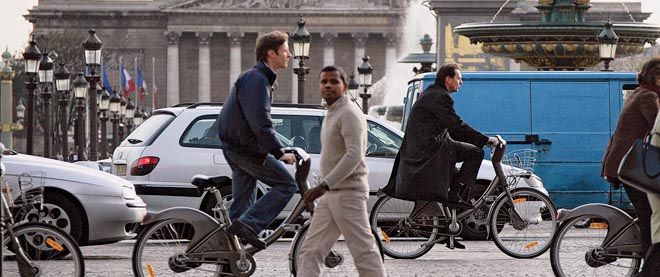Car owners unite against the bike!
Paris drivers fight back against the mayor’s war on cars
Mal Langsdon/Reuters
Share

Every weekday, Juliana Park wakes up in her Paris apartment near leafy Bois de Vincennes park, carries her 10-month-old daughter two blocks to the nearest metro station, drops her at a nanny’s, then heads to work—sometimes by foot, sometimes by bike, but never by car. In fact, the Canadian-born architect is rarely in a car. “You really have no excuse in Paris,” she says.
Park, it seems, is far from the only Parisian going car-free: car use in Paris has dropped 25 per cent in the last 10 years. Bike use, meanwhile, has doubled, and one out of every two trips now happens on foot. Park is glad that, while navigating cobblestone sidewalks, her daughter gets a child’s-eye view of bakeries, crepe stands and schoolchildren on scooters, instead of seeing it all whoosh by from the back seat of a car. “Even though she’s still really young,” says Park, “she’s getting a better sense of her environment.” Paris Mayor Bertrand Delanoë, who has eliminated 23,000 parking spots to make way for bike and bus lanes and built the massively popular Vélib’ bike-sharing network (an idea later copied in Montreal, Toronto and Ottawa), is at least partly responsible for Paris’s new, bike-friendly face. But the mayor’s latest plan—to pedestrianize a section of the Seine riverbank—is causing a powerful lobby group, 40 millions d’automobilistes, to fight back. “We can no sooner eliminate cars from Paris roads than empty the Seine of water,” says executive director Pierre Chasseray. “Delanoë is living a fantasy.”
The Socialist mayor, who was elected in 2001 on a platform of creating more “civilized space” in the City of Light, is attempting to transform the Seine, the grand river that cuts through the heart of the French capital. Since the ’60s, cars have zoomed along beside it on water-level expressways that bisect the city. Shortly after he was voted in, the mayor began shutting several lanes of traffic every summer, and put in some small sandy beaches on the roadway for Parisians who couldn’t afford to head south.
This fall, Delanoë narrowed the expressway on the city’s right bank, doubling the width of sidewalks next to it. The mayor put up traffic lights along the expressway, designed to slow cars and give pedestrians easier access to the riverside. “This area has turned into a living space,” says plasterer Alain Corre, who sat eating his lunch in the new green space created on the former roadway. “The cars are still there, but now they have to share.”
But Delanoë’s intention to remove part of a busy city artery has some Parisians up in arms. The mayor wants to eliminate a section of the Left Bank route—between the Musée d’Orsay and the Pont de l’Alma—and replace it with 4.5 hectares of parks, floating botanical gardens and a flower market. Critics worry about where all the traffic will go. Rachida Dati, the mayor of the seventh arrondissement—and a minister in former president Nicolas Sarkozy’s government—believes it will significantly increase traffic along Paris’s smaller urban routes.
Tourists are among those who should be alarmed, says Chasseray. The city doesn’t dispute estimates that up to 1,000 cars an hour will be forced onto scenic boulevards like the Champs-Elysées, rue de Rivoli and boul. Saint-Germain. “There will be more traffic jams, and it will ruin the image for tourists of a city where cars and people move fluidly,” says Chasseray. His organization recently launched an online petition against the plans for the Seine; within the first two days, more than 6,000 people had signed on.
“We’re not against cars,” says Damien Stéffan, a spokesperson for the City of Paris. “We’re against the vision that cars are the only way to get around.” Stéffan admits that when Delanoë’s latest plans are implemented it will take six more minutes to cross the city in rush-hour traffic. But he believes the increase—to 37 minutes—will be reduced when more drivers give up their cars and take public transit.
Still, the economic climate may yet upset Delanoë’s plans. France is expected to see less than one per cent growth this year; in July, Peugeot Citroën, the iconic French carmaker, announced it was laying off tens of thousands of workers in an industry that employs 10 per cent of the workforce. President François Hollande may wish to revisit his support for the mayor’s project. A cartoon in a recent edition of Le Parisien showed the new Socialist president cautioning the mayor as he doled out parking tickets, with the caption: “You know, Delanoë, you’re not exactly helping us jump-start the auto industry.”